
Litoria is a genus of Pelodryadidae tree frogs native to Australia, the Bismarck Archipelago, the Solomon Islands, New Guinea, the Lesser Sunda Islands, and the Moluccan Islands. It is the only genus in the monotypic subfamily Litoriinae and are sometimes collectively referred to as Australasian treefrogs. They are distinguishable from other tree frogs by the presence of horizontal irises, no pigmentation of the eyelids, and their distribution east and south from Wallacea. Over 90 species are described, but several new species are described every year on average, such as the Pinocchio frog, discovered in 2008 and described in 2019.

Tyler's tree frog or the southern laughing tree frog is an arboreal tree frog. It is native to eastern Australia. It occurs from southeast Queensland to the south coast of New South Wales. It is generally a coastal species and is not found inland.
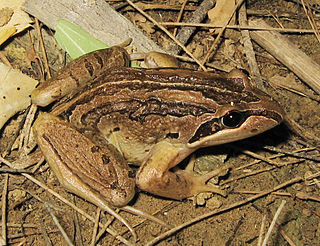
The striped marsh frog or brown-striped frog is a predominantly aquatic frog native to coastal Eastern Australia. It is a common species in urban habitats.
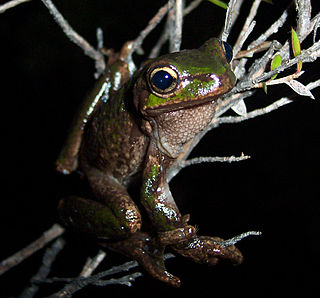
The Tasmanian tree frog is a species of tree frog that is found on the west coast of Tasmania, Australia. The name king tree frog is also used for the species. The tree frog was first found by Myrtle Burrows in 1941, at Cradle Mountain and handed over to Scott Oswald, who is attributed with the discovery.

The motorbike frog is a ground-dwelling tree frog of the family Pelodryadidae found in Southwest Australia. Its common name is derived from the male frog's mating call, which sounds similar to a motorbike changing up through gears; it is also known as Moore's frog, the western bell frog, western green and golden bell frog, and western green tree frog.

Amphibians of Australia are limited to members of the order Anura, commonly known as frogs. All Australian frogs are in the suborder Neobatrachia, also known as the modern frogs, which make up the largest proportion of extant frog species. About 230 of the 5,280 species of frog are native to Australia with 93% of them endemic. Compared with other continents, species diversity is low, and may be related to the climate of most of the Australian continent. There are two known invasive amphibians, the cane toad and the smooth newt.
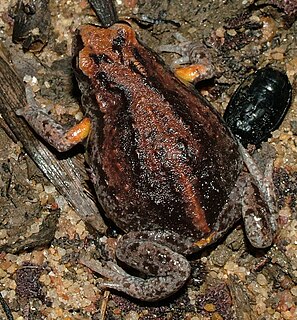
The large toadlet or great toadlet or major toadlet is a species of ground-dwelling frog native to eastern Queensland (including Moreton and North Stradbroke Island and northern New South Wales, Australia.

Ranoidea verrucosa,, is an amphibian native to northern New South Wales and south-eastern Queensland, Australia. It is also classified under the genus of Cyclorana and Litoria and also known as the Warty Water-holding Frog.

The long-thumbed frog, Fletcher's frog or barking marsh frog is a species of non-burrowing ground frog native to south-eastern Australia. The species belongs to the genus Limnodynastes. The twelve species in the genus are characterised by a lack of toe pads. Following phylogenetic analysis, the species was placed in L. peronii clade group alongside L. depressus, L.tasmaniensis and L. peronii.

The Main's frog is a species of frog in the family Pelodryadidae. It is endemic to Western and Central Australia.
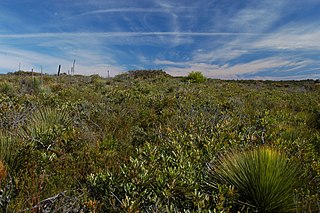
Wallum, or wallum country, is an Australian ecosystem of coastal south-east Queensland, extending into north-eastern New South Wales. It is characterised by flora-rich shrubland and heathland on deep, nutrient-poor, acidic, sandy soils, and regular wildfire. Seasonal changes in the water table due to rainfall may create swamps. The name is derived from the Kabi word for the wallum banksia.
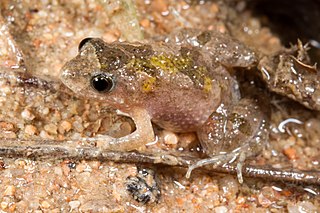
The desert froglet is a species of frog in the family Myobatrachidae, endemic to Australia. The species is not under any threat of extinction. Desert froglets occur mainly in dry or moist savanna habitats, principally from the mid-western border of Northern Territory, south-east into western Queensland and New South Wales and the north-east corner of South Australia. They can also be found along the Queensland coast where it has been recorded between Townsville and Cooktown, and as far south as Hervey Bay.
The Strike-a-Light River, a perennial stream that is part of the Murrumbidgee catchment within the Murray–Darling basin, is located in the Snowy Monaro Regional Council area of New South Wales, Australia.

The Wolli Creek Regional Park is a 50 hectares regional park, located adjacent to Wolli Creek within the Wolli Creek Valley, between Bexley North and Tempe in south-west Sydney, New South Wales, Australia.
The brown frog (Rana) is a genus of about 50 species of true frogs found through much of Eurasia, North America, Africa, Central America, and the northern half of South America.
Striped frog may refer to:
Margaret Davies is an Australian herpetologist born on 8 November 1944. She worked at the University of Adelaide studying Australian frogs, retiring in 2002. Initially appointed to a teaching post at the university, she was inspired to research frog taxonomy and their ecology from the 1970s. She identified over 30 new species of frogs during her career. She has contributed to over 120 publications.